The Cambridge History of China. Vol. 13: Republican China 1912-1949, Part 2
Подождите немного. Документ загружается.


THE YENAN FORUM 481
content. In so doing, he also imposed certain limitations on the themes
and subject-matter of socialist realism. The peasant-worker-soldier nexus
dictated a confining scope of such themes as land reform, struggles against
landlordism, guerrilla warfare, and industrial construction. And the rigid
manner in which the Maoist literary bureaucrats later carried out such
specifications, leaving little room for writers to reinterpret the canon or
to fill in its gaps, served only further to cripple creative efforts even to
produce good socialist literature.
Yenan literature
The most pronounced feature of Yenan literary practice immediately after
the Talks was its experimentation with native folk forms and idioms.
According to Lu Ting-i, Mao's Talks prompted the emergence, in the
order of popularity, of the following new types of literature and art: (i)
folk dance and folk drama; (2) woodcuts in the 'national' style; (3)
novels and stories in the traditional style of story-telling; (4) poetry in
imitation of the folk-song rhythm and idiom.
142
All of them involved
folk elements and apparently appealed, directly or indirectly, to the
'audio-visual' senses of the mass audience.
The best example - and the most prevalent - of this new folk culture
was the jang-ko ('rice-sprout song'), a local song-and-dance which
became immensely popular in the 'liberated' areas. Originally a ritual
dance performed by villagers during the lunar new year, it was spotted
by Yenan cadres for its propaganda potential. A certain Liu Chih-jen is
said to have been the first to modernize this folk form by instilling
revolutionary content and by combining it with other forms of popular
theatre. Aside from the jang-ko dance, the 'jang-ko opera' was invented,
which fusedyang-ko dance steps with local folk songs, modern costumes,
and dramatic gestures and expressions borrowed from Peking opera. Both
forms provided opportunities for mass participation, and reportedly
everyone in Yenan was soon dancing the yang-ko. In 1943, a new yang-ko
campaign was launched which resulted in the production of fifty-six new
yang-ko operas.
143
The most famous of these was Pai-mao nii (The
white-haired girl), a collaborative effort by the staff members of the Lu
Hsun Academy of Arts and Literature in Yenan, who turned an apparently
real story into a ' first-rate melodrama' about a servant girl who, exploited
142
Ibid.
246. For
a
detailed analysis
of
the various forms
of
Yenan literature, see Kikuchi Saburo,
Cbugoku gcndai bungaku shi (History
of
contemporary Chinese literature), vol.2, chs. 2—5. See also
Ting Miao, P'ing Cbung-kung wen-i tai-piao
/so
(On representative works
of
Chinese Communist
literature).
143
Lan Hai, 77-8; Liu Shou-sung, 2.24.
Cambridge Histories Online © Cambridge University Press, 2008
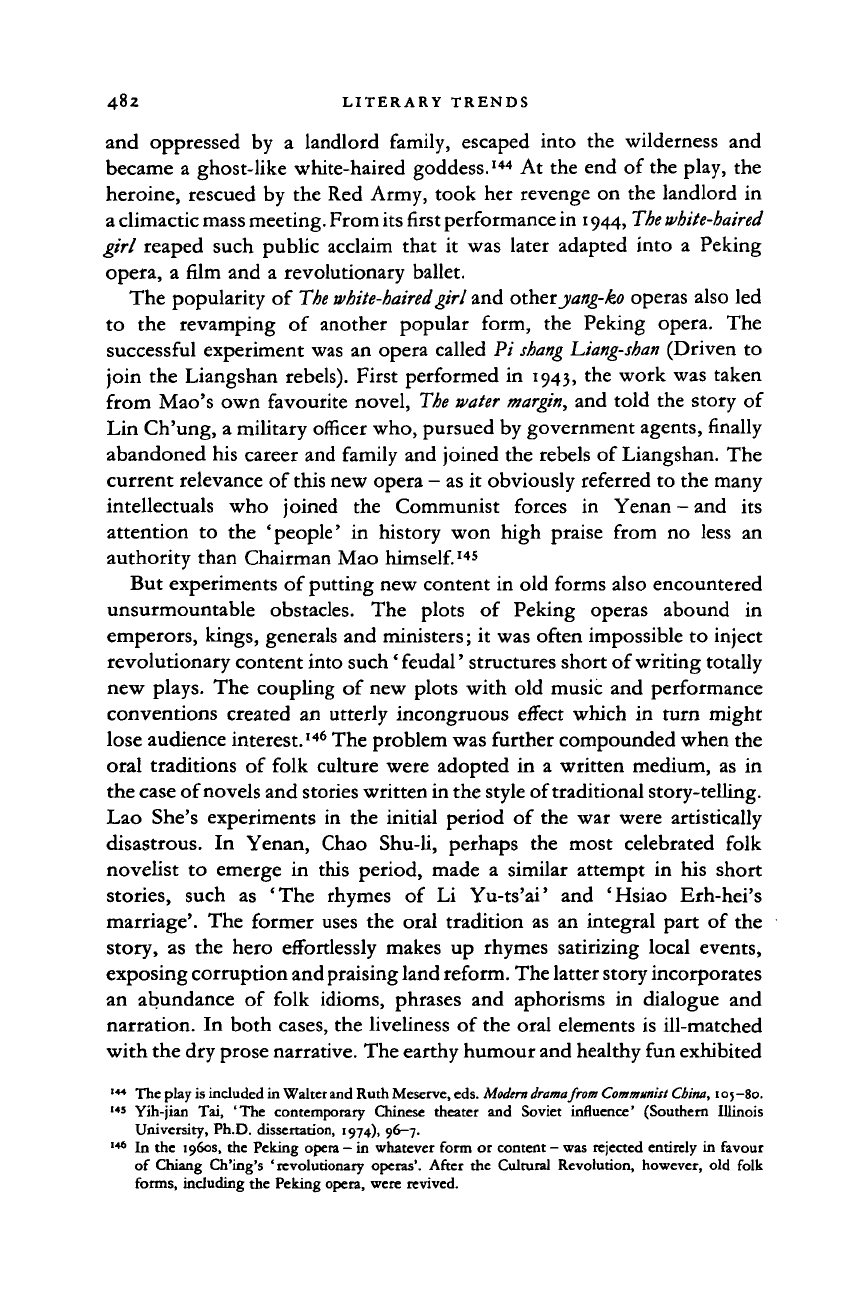
482 LITERARY TRENDS
and oppressed by a landlord family, escaped into the wilderness and
became a ghost-like white-haired goddess.
144
At the end of the play, the
heroine, rescued by the Red Army, took her revenge on the landlord in
a climactic mass meeting. From its
first
performance
in
1944, The white-haired
girl reaped such public acclaim that it was later adapted into a Peking
opera, a film and a revolutionary ballet.
The popularity of
The
white-haired girl and other jang-ko operas also led
to the revamping of another popular form, the Peking opera. The
successful experiment was an opera called Pi
shang Liang-shan
(Driven to
join the Liangshan rebels). First performed in 1943, the work was taken
from Mao's own favourite novel,
The
water
margin,
and told the story of
Lin Ch'ung, a military officer who, pursued by government agents, finally
abandoned his career and family and joined the rebels of Liangshan. The
current relevance of this new opera - as it obviously referred to the many
intellectuals who joined the Communist forces in Yenan - and its
attention to the 'people' in history won high praise from no less an
authority than Chairman Mao
himself.
145
But experiments of putting new content in old forms also encountered
unsurmountable obstacles. The plots of Peking operas abound in
emperors, kings, generals and ministers; it was often impossible to inject
revolutionary content into such 'feudal' structures short of writing totally
new plays. The coupling of new plots with old music and performance
conventions created an utterly incongruous effect which in turn might
lose audience interest.
146
The problem was further compounded when the
oral traditions of folk culture were adopted in a written medium, as in
the case of novels and stories written in the style of traditional story-telling.
Lao She's experiments in the initial period of the war were artistically
disastrous. In Yenan, Chao Shu-li, perhaps the most celebrated folk
novelist to emerge in this period, made a similar attempt in his short
stories, such as 'The rhymes of Li Yu-ts'ai' and 'Hsiao Erh-hei's
marriage'. The former uses the oral tradition as an integral part of the
story, as the hero effortlessly makes up rhymes satirizing local events,
exposing corruption and praising land reform. The latter story incorporates
an abundance of folk idioms, phrases and aphorisms in dialogue and
narration. In both cases, the liveliness of the oral elements is ill-matched
with the dry prose narrative. The earthy humour and healthy fun exhibited
144
The play is included in Walter and Ruth Meserve, eds. Modern drama from Communist China, 105—80.
145
Yih-jian
Tai, 'The
contemporary Chinese theater
and
Soviet influence' (Southern Illinois
University, Ph.D. dissertation, 1974), 96—7.
146
In
the 1960s, the Peking opera
—
in whatever form
or
content
-
was rejected entirely
in
favour
of Chiang Ch'ing's 'revolutionary operas'. After
the
Cultural Revolution, however,
old
folk
forms, including the Peking opera, were revived.
Cambridge Histories Online © Cambridge University Press, 2008
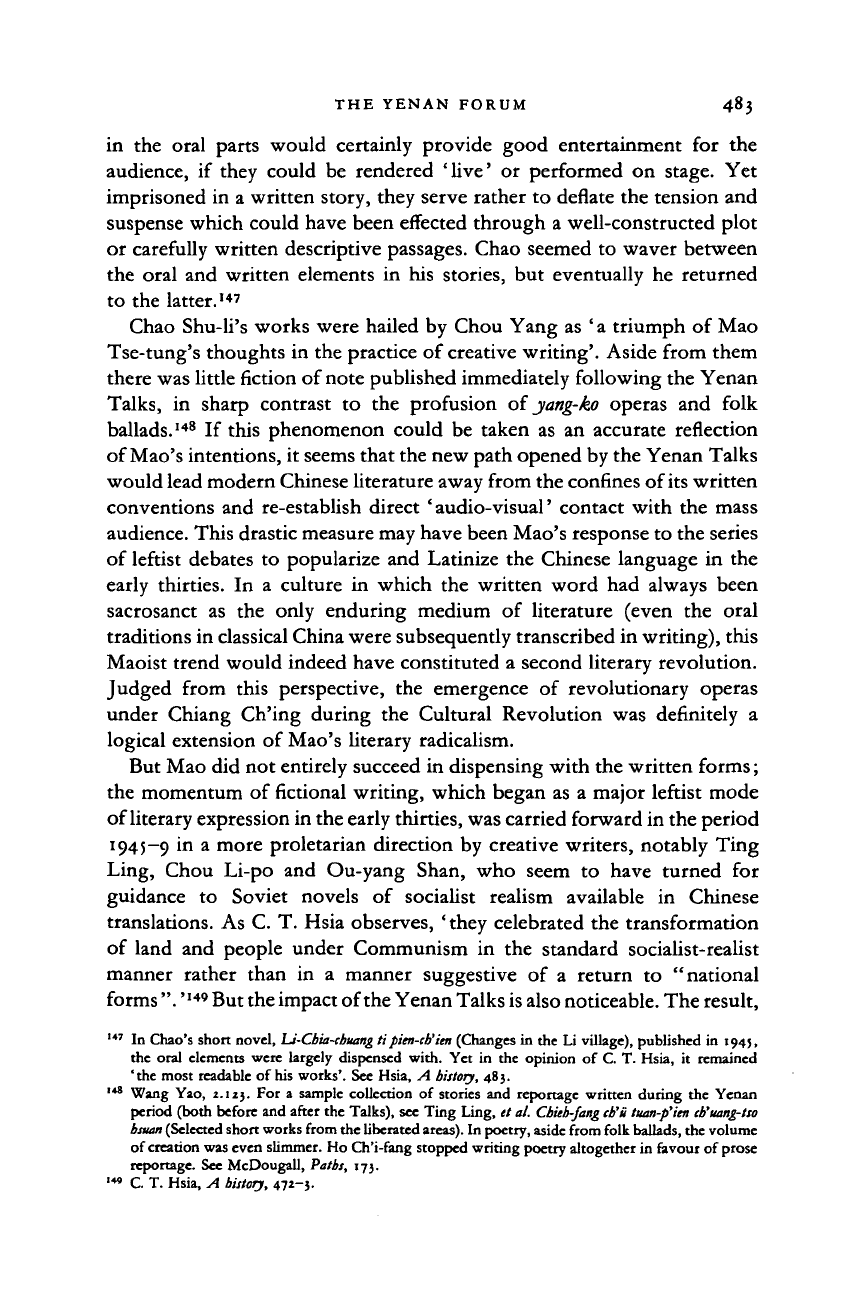
THE YENAN FORUM 483
in the oral parts would certainly provide good entertainment for the
audience, if they could be rendered 'live' or performed on stage. Yet
imprisoned in a written story, they serve rather to deflate the tension and
suspense which could have been effected through a well-constructed plot
or carefully written descriptive passages. Chao seemed to waver between
the oral and written elements in his stories, but eventually he returned
to the latter.
147
Chao Shu-li's works were hailed by Chou Yang as
' a
triumph of Mao
Tse-tung's thoughts in the practice of creative writing'. Aside from them
there was little fiction of note published immediately following the Yenan
Talks,
in sharp contrast to the profusion of
yang-ko
operas and folk
ballads.
148
If this phenomenon could be taken as an accurate reflection
of Mao's intentions, it seems that the new path opened by the Yenan Talks
would lead modern Chinese literature away from the confines of its written
conventions and re-establish direct ' audio-visual' contact with the mass
audience. This drastic measure may have been Mao's response to the series
of leftist debates to popularize and Latinize the Chinese language in the
early thirties. In a culture in which the written word had always been
sacrosanct as the only enduring medium of literature (even the oral
traditions in classical China were subsequently transcribed in writing), this
Maoist trend would indeed have constituted a second literary revolution.
Judged from this perspective, the emergence of revolutionary operas
under Chiang Ch'ing during the Cultural Revolution was definitely a
logical extension of Mao's literary radicalism.
But Mao did not entirely succeed in dispensing with the written forms;
the momentum of fictional writing, which began as a major leftist mode
of literary expression in the early thirties, was carried forward in the period
1945—9 in a more proletarian direction by creative writers, notably Ting
Ling, Chou Li-po and Ou-yang Shan, who seem to have turned for
guidance to Soviet novels of socialist realism available in Chinese
translations. As C. T. Hsia observes, 'they celebrated the transformation
of land and people under Communism in the standard socialist-realist
manner rather than in a manner suggestive of a return to "national
forms ".
>149
But the impact of the Yenan Talks
is
also
noticeable.
The result,
147
In Qiao's short novel, U-Cbia-cbuang tipim-cb'itn (Changes
in
the
Li
village), published
in
194J,
the oral elements were largely dispensed with. Yet
in the
opinion
of
C.
T.
Hsia,
it
remained
'the most readable
of
his works'. See Hsia,
A
history, 483.
148
Wang Yao, 2.123. For
a
sample collection
of
stories and reportage written during the Yenan
period (both before and after the Talks), see Ting Ling,
et
al. Cbieb-fang
cb'i
tuan-p'ien cb'uang-tso
bsuan (Selected short works from the liberated areas). In poetry, aside from folk ballads, the volume
of creation was even slimmer. Ho Ch'i-fang stopped writing poetry altogether in favour
of
prose
reportage. See McDougall, Paths, 173.
149
C T. Hsia, A
history,
472-3.
Cambridge Histories Online © Cambridge University Press, 2008

484 LITERARY TRENDS
therefore, was at best a mixed blessing. The case of Ting Ling is a most
illuminating example.
Ting Ling was probably the best example of the romantic writer turned
leftist; she was also the most prestigious writer in Yenan. Some of her
better stories, such as 'New convictions' (1939) and 'When I was in Hsia
village' (1940), were written before the Yenan Forum.
IS0
Both stories deal
with peasant resistance to Japanese aggression, and Ting Ling imbues her
rural characters, especially the heroine of the latter story, with a mature
nobility and humanism in the best tradition of leftist fiction of the 1930s.
After the Yenan Forum, which was convened partly to criticize writers
like Ting Ling, she was reportedly ' caught up in the high tide of learning
from the rectification movement'.
151
Instead of fiction, she wrote only
journalistic pieces - records of her field work in the midst of the rural
masses. Finally in 1949 her long novel,
Tai-yang chao-tsai Sang-kan
ho
shang
(The sun shines over the Sangkan River), was published and won the Stalin
Second Prize for Literature in 1951.
Ting Ling had conceived of portraying the process of land reform in
a fictional trilogy, of which
The
Sangkan
River dealt only with the initial
phase of ' struggle'. The second and third parts
—
on redivision of land
and militarization of the peasantry
—
were never written. This grand
design might have been Ting Ling's ultimate statement of her devotion
to the Chinese Communist Party and to the cause of social revolution.
Ironically, the very success of
the
first volume brought about her eventual
purge for being, among other charges, a 'one-book' author.
As a novel, The
Sangkan
River stands as an ambitious experiment. It
presents a series of vignettes and a mosaic of character portraits, all loosely
connected, which bring a vivid sense of life to the rural locale which Ting
Ling had come to know so
well.
At the mid-point of the novel, Ting Ling
introduces her 'positive hero', the model Communist cadre Chang P'in,
who crosses over from the other side of the river and gradually, but
masterfully, sets in motion the mechanism of peasant organization which
finally culminates in a mass struggle meeting. Apparently Ting Ling
intended her new novel to be documentary fiction, a new literary genre
that had become popular during the early war years. It was also meant
to be ' socialist realism', in the Soviet manner, which encompasses reality
'collectively' and 'positively' so that the intended effect would be, as
Mao stated, 'more typical, more ideal, and therefore more universal than
actual everyday life'. Yet the weaknesses of the novel stem also from this
150
A
translation
of
the latter story can
be
found
in
Lau, Hsia and Lee, eds., 268-78.
151
Wang
Yao,
2.12j.
On
Ting Ling's writing overall,
see
Yi-tsi Feuerwerker, Ding Langs
fiction
-
ideology and narrative
in
modern Chinese literature.
Cambridge Histories Online © Cambridge University Press, 2008
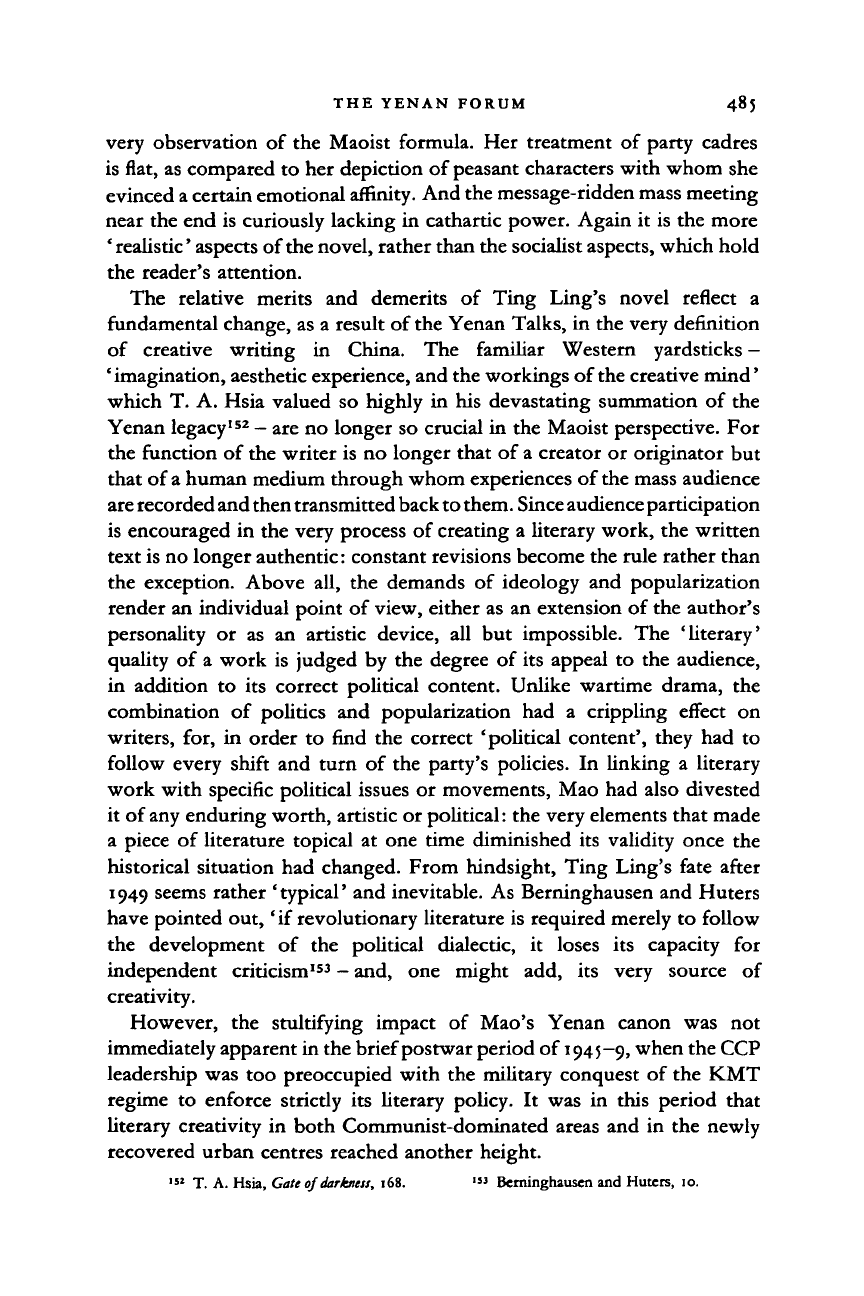
THE YENAN FORUM 485
very observation of the Maoist formula. Her treatment of party cadres
is flat, as compared to her depiction of peasant characters with whom she
evinced a certain emotional affinity. And the message-ridden mass meeting
near the end is curiously lacking in cathartic power. Again it is the more
'
realistic'
aspects of the novel, rather than the socialist aspects, which hold
the reader's attention.
The relative merits and demerits of Ting Ling's novel reflect a
fundamental change, as a result of the Yenan Talks, in the very definition
of creative writing in China. The familiar Western yardsticks -
'imagination, aesthetic experience, and the workings of
the
creative mind'
which T. A. Hsia valued so highly in his devastating summation of the
Yenan legacy
152
- are no longer so crucial in the Maoist perspective. For
the function of the writer is no longer that of a creator or originator but
that of
a
human medium through whom experiences of
the
mass audience
are
recorded and then transmitted back to them. Since audience participation
is encouraged in the very process of creating a literary work, the written
text is no longer authentic: constant revisions become the rule rather than
the exception. Above all, the demands of ideology and popularization
render an individual point of view, either as an extension of the author's
personality or as an artistic device, all but impossible. The 'literary'
quality of a work is judged by the degree of its appeal to the audience,
in addition to its correct political content. Unlike wartime drama, the
combination of politics and popularization had a crippling effect on
writers, for, in order to find the correct 'political content', they had to
follow every shift and turn of the party's policies. In linking a literary
work with specific political issues or movements, Mao had also divested
it of
any
enduring worth, artistic or political: the very elements that made
a piece of literature topical at one time diminished its validity once the
historical situation had changed. From hindsight, Ting Ling's fate after
1949 seems rather 'typical' and inevitable. As Berninghausen and Huters
have pointed out, 'if revolutionary literature is required merely to follow
the development of the political dialectic, it loses its capacity for
independent criticism
153
- and, one might add, its very source of
creativity.
However, the stultifying impact of Mao's Yenan canon was not
immediately apparent in the brief postwar period of
1945-9,
when the CCP
leadership was too preoccupied with the military conquest of the KMT
regime to enforce strictly its literary policy. It was in this period that
literary creativity in both Communist-dominated areas and in the newly
recovered urban centres reached another height.
ls2
T. A. Hsia, Gate of darkness, 168. '" Berninghausen and Huters, 10.
Cambridge Histories Online © Cambridge University Press, 2008
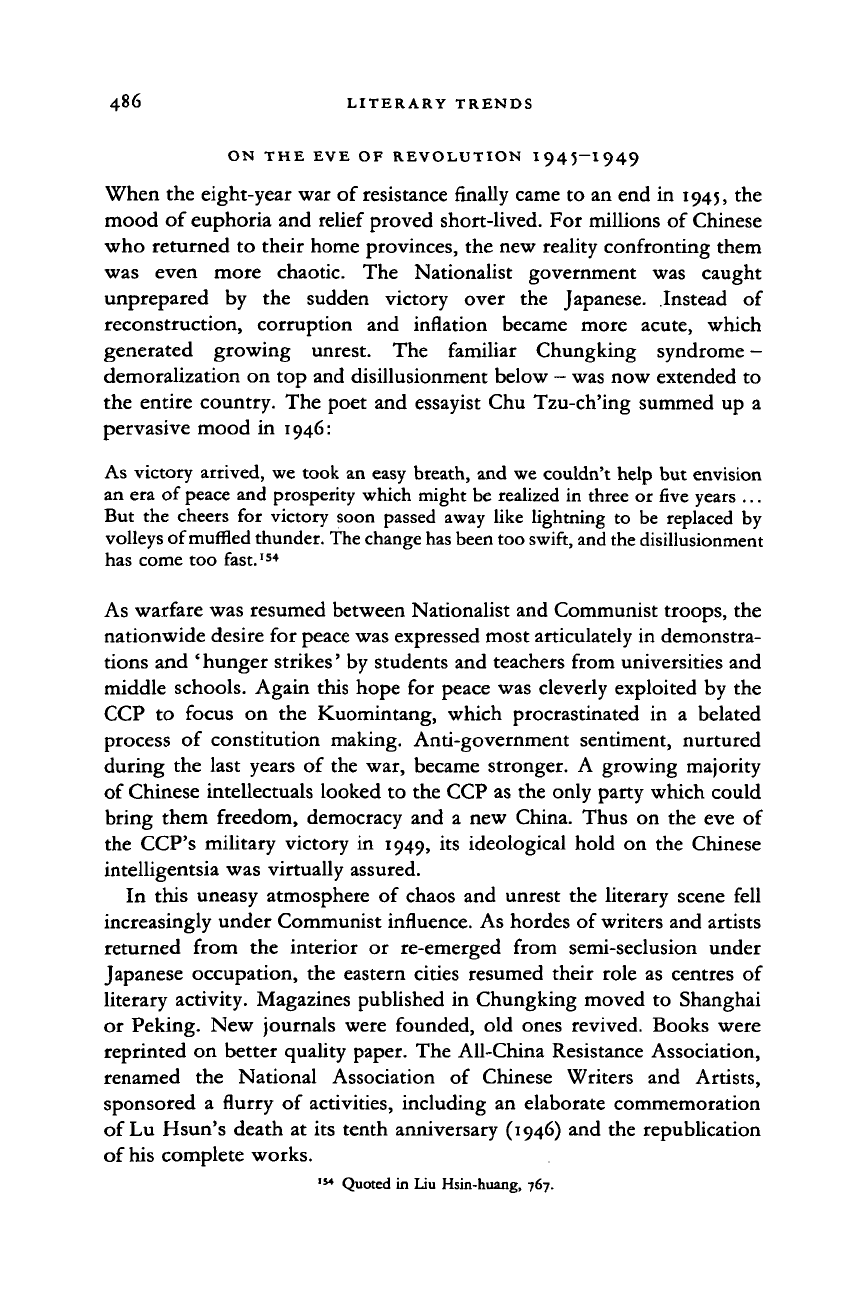
486 LITERARY TRENDS
ON THE EVE OF REVOLUTION I945-I949
When the eight-year war of resistance finally came to an end in 1945, the
mood of euphoria and relief proved short-lived. For millions of Chinese
who returned to their home provinces, the new reality confronting them
was even more chaotic.
The
Nationalist government
was
caught
unprepared
by the
sudden victory over
the
Japanese. Instead
of
reconstruction, corruption
and
inflation became more acute, which
generated growing unrest.
The
familiar Chungking syndrome
-
demoralization on top and disillusionment below
-
was now extended
to
the entire country. The poet and essayist Chu Tzu-ch'ing summed up
a
pervasive mood
in
1946:
As victory arrived, we took an easy breath, and we couldn't help but envision
an era of peace and prosperity which might be realized in three or five years
...
But the cheers
for
victory soon passed away like lightning
to
be replaced by
volleys of muffled thunder.
The
change
has
been too swift, and the disillusionment
has come too fast.
154
As warfare was resumed between Nationalist and Communist troops, the
nationwide desire for peace was expressed most articulately in demonstra-
tions and ' hunger strikes' by students and teachers from universities and
middle schools. Again this hope for peace was cleverly exploited by the
CCP
to
focus
on the
Kuomintang, which procrastinated
in a
belated
process
of
constitution making. Anti-government sentiment, nurtured
during the last years
of
the war, became stronger.
A
growing majority
of Chinese intellectuals looked to the CCP as the only party which could
bring them freedom, democracy and
a
new China. Thus
on
the eve
of
the CCP's military victory
in
1949,
its
ideological hold
on
the Chinese
intelligentsia was virtually assured.
In this uneasy atmosphere
of
chaos and unrest the literary scene fell
increasingly under Communist influence. As hordes of writers and artists
returned from
the
interior
or
re-emerged from semi-seclusion under
Japanese occupation, the eastern cities resumed their role
as
centres
of
literary activity. Magazines published
in
Chungking moved
to
Shanghai
or Peking. New journals were founded, old ones revived. Books were
reprinted on better quality paper. The All-China Resistance Association,
renamed
the
National Association
of
Chinese Writers
and
Artists,
sponsored
a
flurry
of
activities, including
an
elaborate commemoration
of Lu Hsun's death
at
its tenth anniversary (1946) and the republication
of his complete works.
IM
Quoted
in
Liu Hsin-huang, 767.
Cambridge Histories Online © Cambridge University Press, 2008
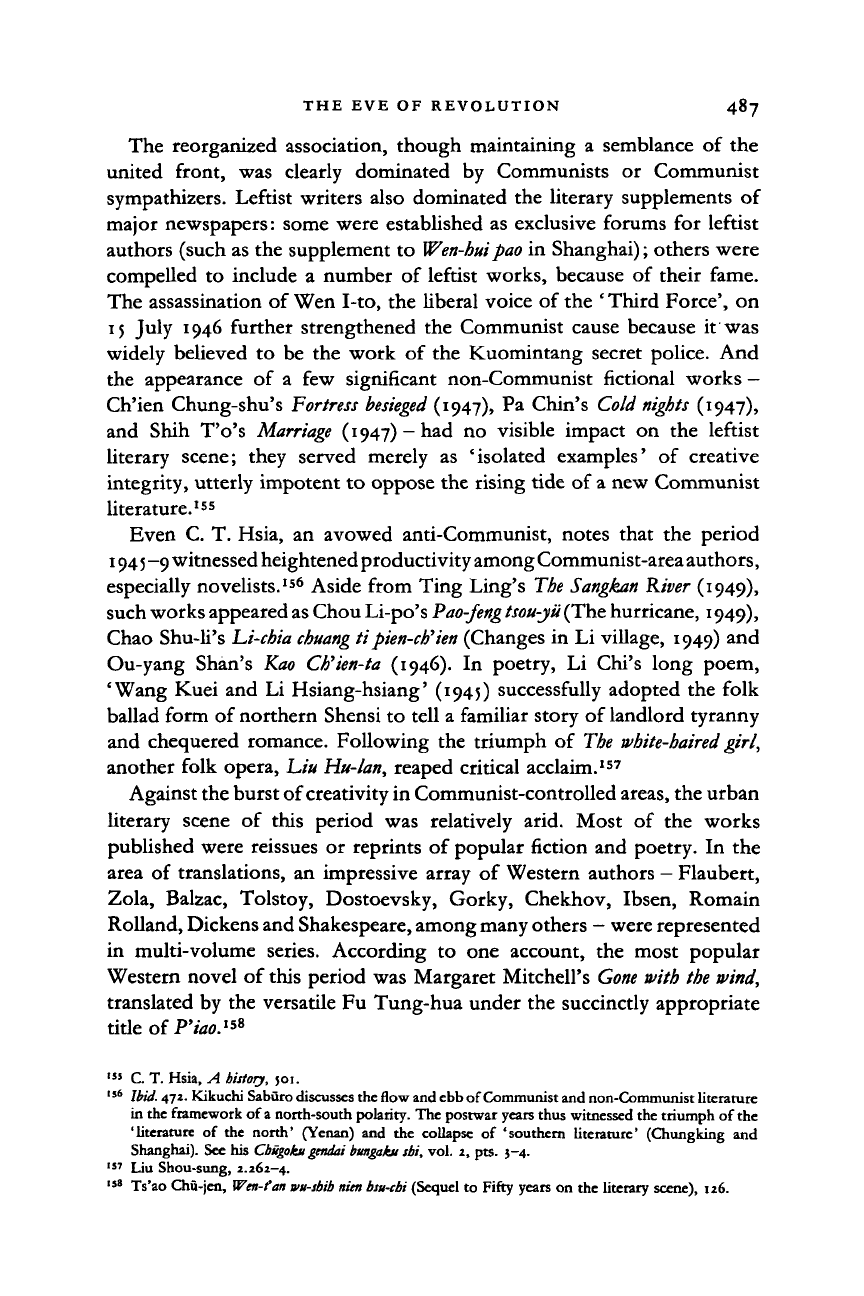
THE EVE OF REVOLUTION 487
The reorganized association, though maintaining a semblance of the
united front, was clearly dominated by Communists or Communist
sympathizers. Leftist writers also dominated the literary supplements of
major newspapers: some were established as exclusive forums for leftist
authors (such as the supplement to
Wen-hutpao
in Shanghai); others were
compelled to include a number of leftist works, because of their fame.
The assassination of Wen I-to, the liberal voice of the ' Third Force', on
15 July 1946 further strengthened the Communist cause because it was
widely believed to be the work of the Kuomintang secret police. And
the appearance of a few significant non-Communist fictional works -
Ch'ien Chung-shu's
Fortress besieged
(1947), Pa Chin's
Cold nights
(1947),
and Shih T'o's
Marriage
(1947)-had no visible impact on the leftist
literary scene; they served merely as 'isolated examples' of creative
integrity, utterly impotent to oppose the rising tide of a new Communist
literature.'
55
Even C. T. Hsia, an avowed anti-Communist, notes that the period
194 5 -9 witnessed heightened productivity among Communist-area authors,
especially novelists.
156
Aside from Ting Ling's
The
Sangkan
River (1949),
such works appeared
as
Chou Li-po's Pao-feng
tsou-yu
(The hurricane, 1949),
Chao Shu-li's
Li-chia chuang tipien-ch'ien
(Changes in Li village, 1949) and
Ou-yang Shan's Kao Ch'ien-ta (1946). In poetry, Li Chi's long poem,
'Wang Kuei and Li Hsiang-hsiang' (1945) successfully adopted the folk
ballad form of northern Shensi to tell a familiar story of landlord tyranny
and chequered romance. Following the triumph of The
white-haired
girl,
another folk opera, Liu
Hu-lan,
reaped critical acclaim.
157
Against the burst of creativity in Communist-controlled
areas,
the urban
literary scene of this period was relatively arid. Most of the works
published were reissues or reprints of popular fiction and poetry. In the
area of translations, an impressive array of Western authors - Flaubert,
Zola, Balzac, Tolstoy, Dostoevsky, Gorky, Chekhov, Ibsen, Romain
Rolland, Dickens and Shakespeare, among many others
—
were represented
in multi-volume series. According to one account, the most popular
Western novel of this period was Margaret Mitchell's
Gone
with
the
wind,
translated by the versatile Fu Tung-hua under the succinctly appropriate
title of P'iao.
IsS
'"
C.
T.
Hsia,
A
history, 501.
156
Ibid.
472. Kikuchi Saburo discusses the flow and ebb of Communist and non-Communist literature
in the framework of a north-south polarity. The postwar years thus witnessed the triumph
of
the
'literature
of
the north' (Yenan)
and the
collapse
of
'southern literature' (Chungking
and
Shanghai). See his Cbigohi getubi bmgaku sbi, vol. 2, pts.
5-4.
157
Liu Shou-sung, 2.262-4.
158
Ts'ao Chu-jen, Wen-fan wu-sbib nitn btu-cbi (Sequel
to
Fifty years
on
the literary scene), 126.
Cambridge Histories Online © Cambridge University Press, 2008
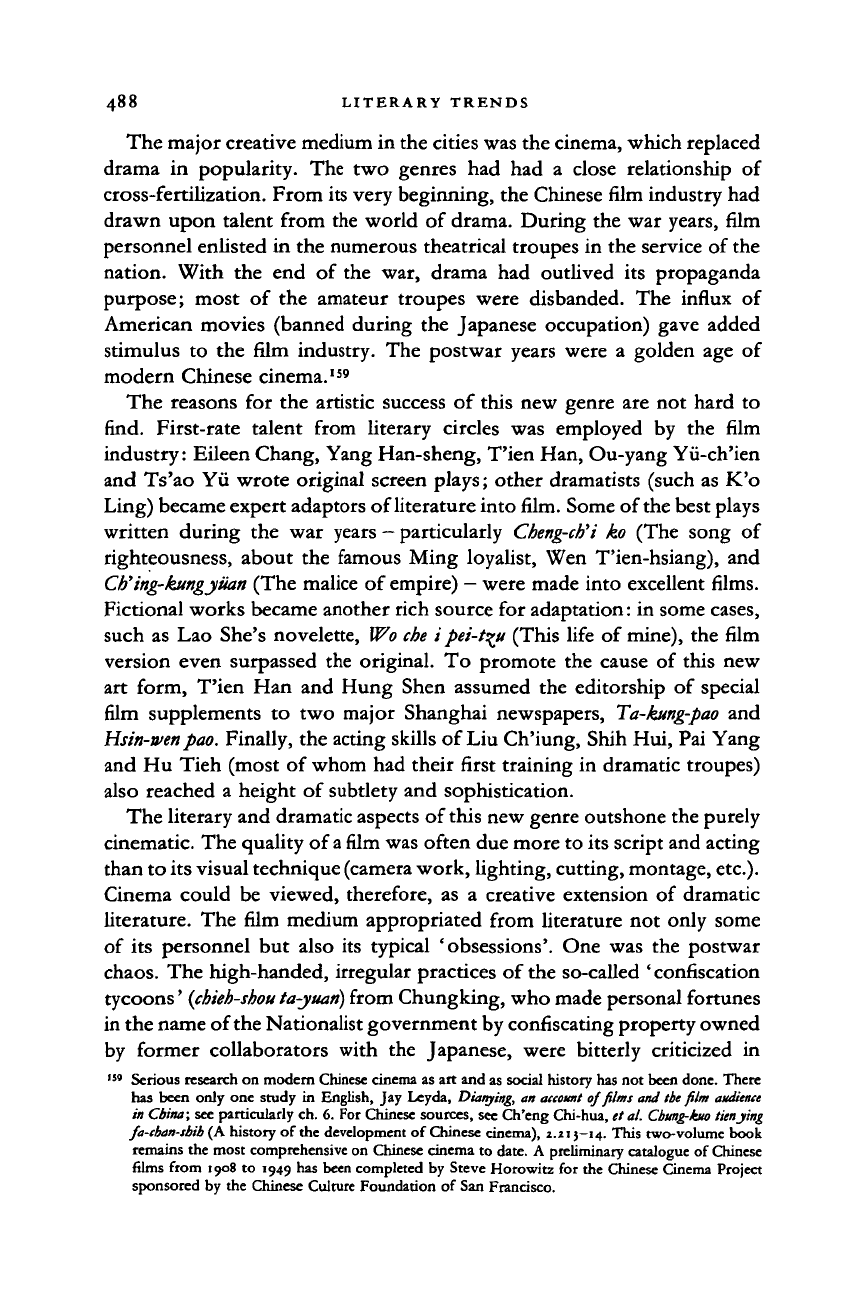
488 LITERARY TRENDS
The major creative medium in the cities was the cinema, which replaced
drama in popularity. The two genres had had a close relationship of
cross-fertilization. From its very beginning, the Chinese film industry had
drawn upon talent from the world of drama. During the war years, film
personnel enlisted in the numerous theatrical troupes in the service of the
nation. With the end of the war, drama had outlived its propaganda
purpose; most of the amateur troupes were disbanded. The influx of
American movies (banned during the Japanese occupation) gave added
stimulus to the film industry. The postwar years were a golden age of
modern Chinese cinema.
159
The reasons for the artistic success of this new genre are not hard to
find. First-rate talent from literary circles was employed by the film
industry: Eileen Chang, Yang Han-sheng, T'ien Han, Ou-yang Yii-ch'ien
and Ts'ao Yii wrote original screen plays; other dramatists (such as K'o
Ling) became expert adaptors of literature into film. Some of the best plays
written during the war years - particularly
Cheng-ch'i
ko (The song of
righteousness, about the famous Ming loyalist, Wen T'ien-hsiang), and
Cb"
ing-kungyiian
(The malice of empire) - were made into excellent films.
Fictional works became another rich source for adaptation: in some cases,
such as Lao She's novelette, Wo
che
i pei-t^u (This life of mine), the film
version even surpassed the original. To promote the cause of this new
art form, T'ien Han and Hung Shen assumed the editorship of special
film supplements to two major Shanghai newspapers,
Ta-kung-pao
and
Hsin-tven
pao.
Finally, the acting skills of Liu Ch'iung, Shih Hui, Pai Yang
and Hu Tieh (most of whom had their first training in dramatic troupes)
also reached a height of subtlety and sophistication.
The literary and dramatic aspects of this new genre outshone the purely
cinematic. The quality of
a
film
was often due more to its script and acting
than to its visual technique (camera work, lighting, cutting, montage, etc.).
Cinema could be viewed, therefore, as a creative extension of dramatic
literature. The film medium appropriated from literature not only some
of its personnel but also its typical 'obsessions'. One was the postwar
chaos.
The high-handed, irregular practices of the so-called ' confiscation
tycoons'
(chieh-shou ta-juan)
from Chungking, who made personal fortunes
in the name of the Nationalist government by confiscating property owned
by former collaborators with the Japanese, were bitterly criticized in
159
Serious research on modern Chinese cinema as art and as social history has not been done. There
has been only one study in English, Jay Leyda,
Dianying,
an
account
of
films
and
tie
film
audience
in
China;
see particularly ch. 6. For Chinese sources, see Ch'eng Chi-hua, et
al.
Cbung-kuo
tienjmg
fa-cban-sbib
(A history of the development of Chinese cinema), 2.113-14. This two-volume book
remains the most comprehensive on Chinese cinema to date. A preliminary catalogue of Chinese
films from 1908 to 1949 has been completed by Steve Horowitz for the Chinese Cinema Project
sponsored by the Chinese Culture Foundation of San Francisco.
Cambridge Histories Online © Cambridge University Press, 2008
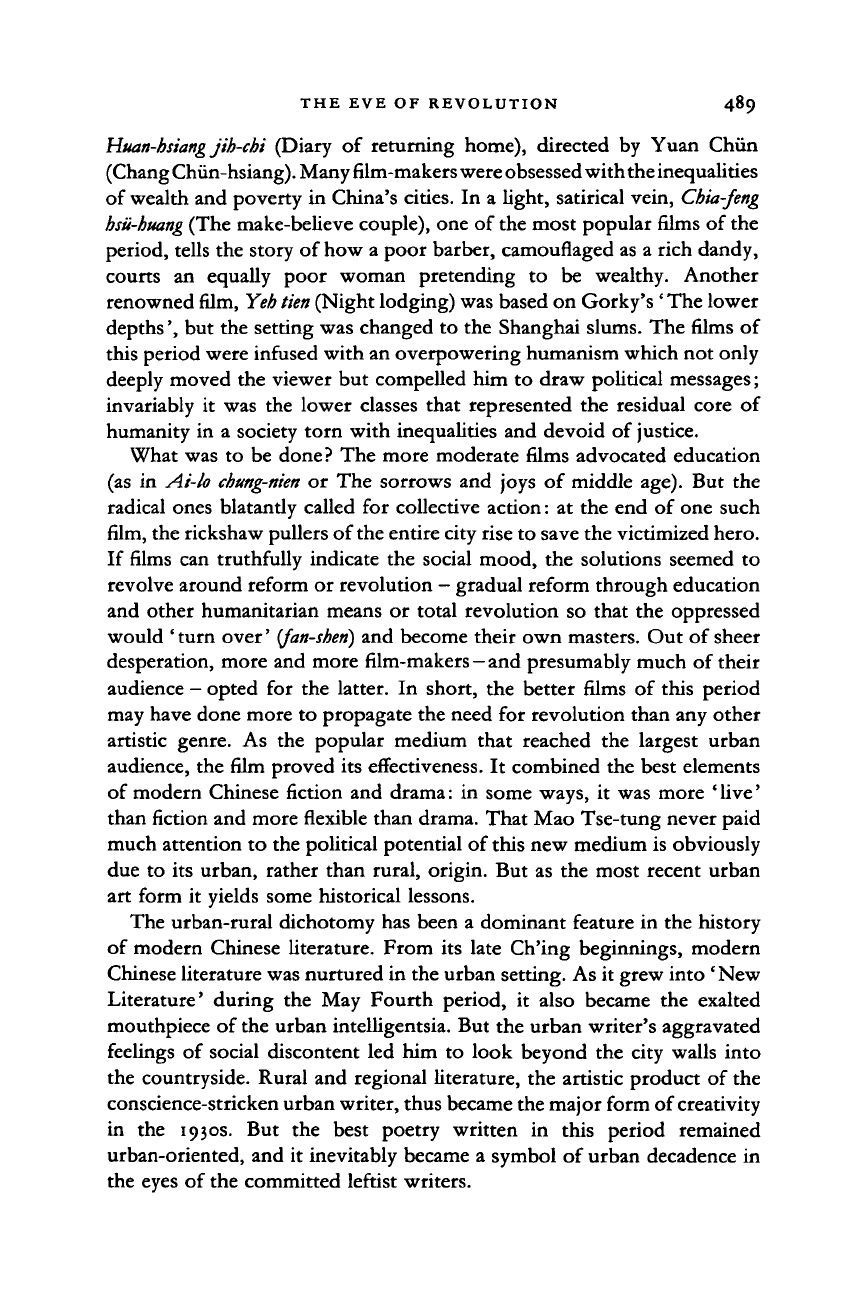
THE EVE OF REVOLUTION 489
Huan-bsiang jib-chi
(Diary of returning home), directed by Yuan Chun
(Chang
Chiin-hsiang).
Many
film-makers
were obsessed with the inequalities
of wealth and poverty in China's cities. In a light, satirical vein,
Chia-feng
hsii-buang
(The make-believe couple), one of the most popular films of the
period, tells the story of how a poor barber, camouflaged as a rich dandy,
courts an equally poor woman pretending to be wealthy. Another
renowned film,
Yeh tien
(Night lodging) was based on Gorky's ' The lower
depths', but the setting was changed to the Shanghai slums. The films of
this period were infused with an overpowering humanism which not only
deeply moved the viewer but compelled him to draw political messages;
invariably it was the lower classes that represented the residual core of
humanity in a society torn with inequalities and devoid of justice.
What was to be done? The more moderate films advocated education
(as in Ai-lo
chung-nien
or The sorrows and joys of middle age). But the
radical ones blatantly called for collective action: at the end of one such
film, the rickshaw pullers of
the
entire city rise to save the victimized hero.
If films can truthfully indicate the social mood, the solutions seemed to
revolve around reform or revolution
—
gradual reform through education
and other humanitarian means or total revolution so that the oppressed
would 'turn over'
(fan-sheri)
and become their own masters. Out of sheer
desperation, more and more film-makers - and presumably much of their
audience
—
opted for the latter. In short, the better films of this period
may have done more to propagate the need for revolution than any other
artistic genre. As the popular medium that reached the largest urban
audience, the film proved its effectiveness. It combined the best elements
of modern Chinese fiction and drama: in some ways, it was more 'live'
than fiction and more flexible than drama. That Mao Tse-tung never paid
much attention to the political potential of this new medium is obviously
due to its urban, rather than rural, origin. But as the most recent urban
art form it yields some historical lessons.
The urban-rural dichotomy has been a dominant feature in the history
of modern Chinese literature. From its late Ch'ing beginnings, modern
Chinese literature was nurtured in the urban setting. As it grew into 'New
Literature' during the May Fourth period, it also became the exalted
mouthpiece of the urban intelligentsia. But the urban writer's aggravated
feelings of social discontent led him to look beyond the city walls into
the countryside. Rural and regional literature, the artistic product of the
conscience-stricken urban writer, thus became the major form of creativity
in the 1930s. But the best poetry written in this period remained
urban-oriented, and it inevitably became a symbol of urban decadence in
the eyes of the committed leftist writers.
Cambridge Histories Online © Cambridge University Press, 2008
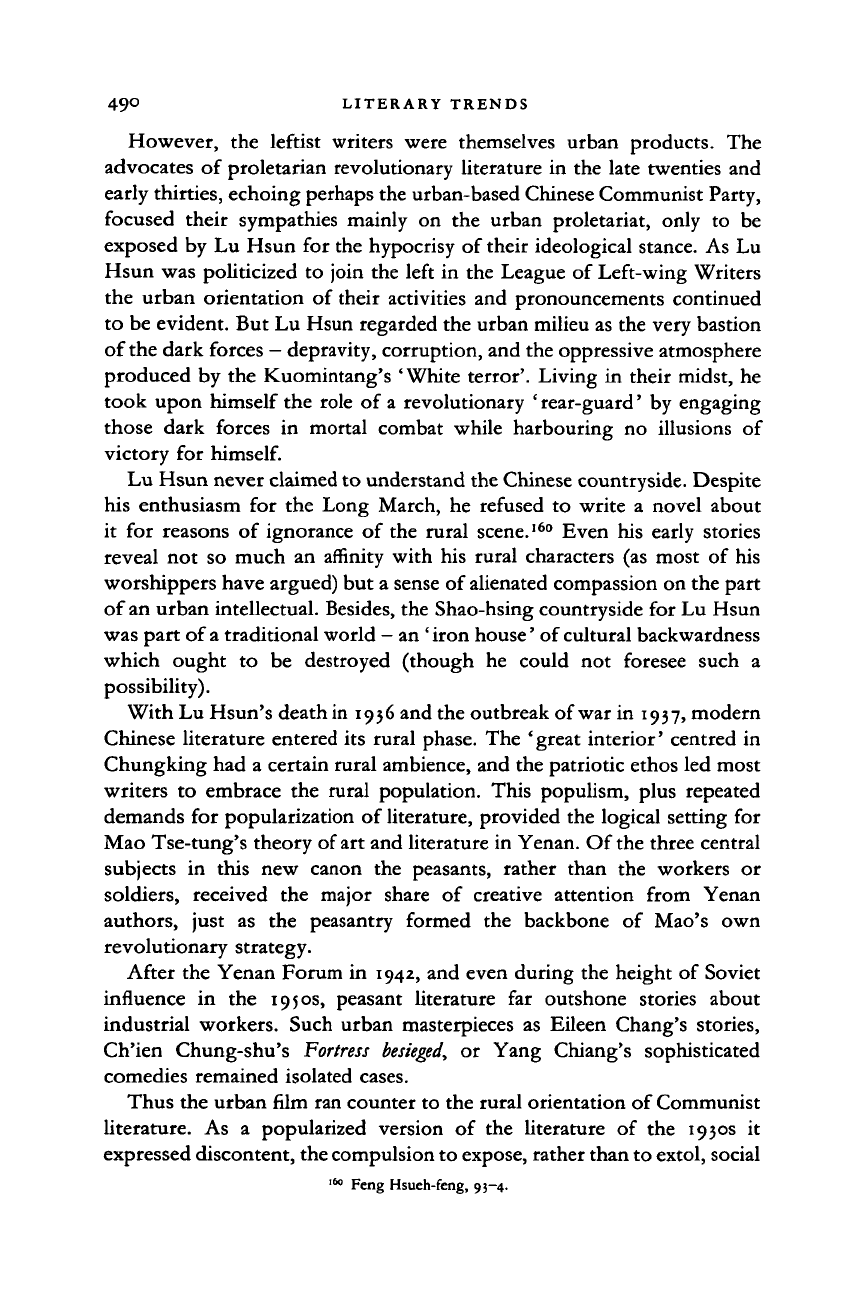
49° LITERARY TRENDS
However,
the
leftist writers were themselves urban products.
The
advocates
of
proletarian revolutionary literature
in
the late twenties and
early thirties, echoing perhaps the urban-based Chinese Communist Party,
focused their sympathies mainly
on the
urban proletariat, only
to be
exposed by Lu Hsun for the hypocrisy of their ideological stance. As Lu
Hsun was politicized
to
join the left
in
the League of Left-wing Writers
the urban orientation
of
their activities and pronouncements continued
to be evident. But Lu Hsun regarded the urban milieu as the very bastion
of the dark forces
—
depravity, corruption, and the oppressive atmosphere
produced by the Kuomintang's 'White terror'. Living
in
their midst, he
took upon himself the role
of
a revolutionary ' rear-guard' by engaging
those dark forces
in
mortal combat while harbouring
no
illusions
of
victory for
himself.
Lu Hsun never claimed to understand the Chinese countryside. Despite
his enthusiasm
for
the Long March,
he
refused
to
write
a
novel about
it
for
reasons
of
ignorance
of
the rural scene.
160
Even his early stories
reveal
not so
much
an
affinity with his rural characters (as most
of
his
worshippers have argued) but a sense of alienated compassion on the part
of an urban intellectual. Besides, the Shao-hsing countryside for Lu Hsun
was part of
a
traditional world
-
an 'iron house' of cultural backwardness
which ought
to be
destroyed (though
he
could
not
foresee such
a
possibility).
With Lu Hsun's death in 1936 and the outbreak of war in 1937, modern
Chinese literature entered its rural phase. The 'great interior' centred
in
Chungking had
a
certain rural ambience, and the patriotic ethos led most
writers
to
embrace
the
rural population. This populism, plus repeated
demands for popularization of literature, provided the logical setting for
Mao Tse-tung's theory of art and literature in Yenan. Of the three central
subjects
in
this
new
canon
the
peasants, rather than
the
workers
or
soldiers, received
the
major share
of
creative attention from Yenan
authors, just
as the
peasantry formed
the
backbone
of
Mao's
own
revolutionary strategy.
After the Yenan Forum in 1942, and even during the height
of
Soviet
influence
in the
1950s, peasant literature
far
outshone stories about
industrial workers. Such urban masterpieces
as
Eileen Chang's stories,
Ch'ien Chung-shu's Fortress
besieged,
or
Yang Chiang's sophisticated
comedies remained isolated cases.
Thus the urban film ran counter to the rural orientation of Communist
literature.
As a
popularized version
of the
literature
of the
1930s
it
expressed discontent, the compulsion to expose, rather than to extol, social
160
Feng Hsueh-feng, 93-4.
Cambridge Histories Online © Cambridge University Press, 2008
